Once I had an occasion to stay at Gainsville in Texas at residence of a doctor friend. A Satsang was organized in the evening. The doctor was a Jam. Hence we had evening meals before sunset at 5.30 p m only The bungalow was situated on very beautiful banks of a wide spread pond. I had stopped the central air condition system and opened all doors and windows before leaving for Satsang. After the Satsang when the doctor family came to leave me in my room they were astonished. I asked: what’s the matter doctor ?“ He was surprised and asked who had opened the doors and windows of my room? I replied that I had done so. They said: “Well Swamiji, here in America, no one keeps doors and windows open.”
A beautiful pond and bungalow situated on the top of a high hill, and I was living on the first floor. Now where is the danger of entry of a thief? No, No, here hardly thieves visit, but what about outside air quietly entering the room?
Whenever I visit America, I have a round of Texas, Florida, North Carolina, Charlot, Maryland, Baltimore, Virginia, Washington, Denver, Atlanta, Los Angeles, California, Detroit, Michigan and Chicago. Most of the people suffer from similar problem of allergy. Young and old alike have breathing problem.
There
is one chief engineer working in a well-known motor car company of Detroit. Both
husband and wife were working in the same department. Both enjoyed happy wedded
life. They have two daughters. Elder daughter had allergy for chick-peas. If
some chick-peas are getting cooked in nearby area she will feel uncomfortable.
Parents would take great care that such a thing does not happen. Unluckily it
happened once. There was an occasion of a birthday of one other engineer’s
daughter of the same company There was a big party and a big assembly in the
evening. All children had got together and enjoyed this programme. It was
arranged in the basement. All children were playing, when unluckily a cooker
burst in the kitchen. Husband and wife were busy in cleaning all the mess. But
the allergic girl started getting suffocation. She could not breathe easily She
ran away to the other room leaving the company of children and lost
consciousness. After cleaning everything in the kitchen the couple visited
basement where children were playing. They did not see the young girl. They
remembered about chickpeas allergy. They found the girl unconscious. Ambulance
was called but before they could reach hospital, it was too late. The birthday
turned into a black day. How would one inform her parents? How to show up the
faces? This is not a story It is not intended to make it any longer. The problem
does not end here. Sunil, the father of the girl went on feeling downhearted.
Mother Sujata just felt herself lost. In America people are accustomed to file a
suit even in small matters. They did not do so. But death of this young girl
broke the strong ties of friendship of the two families.
A similar disease is called eosinophilia. Normally the amount of eosinophils in blood remain between 0% and 4% but when there is dust in the atmosphere, smoke, fog, coal-tar smoke, fumes of incense sticks,scent is sprayed, white wash and painting and where there is dampness as well as change in season, even if flowers of the neem trees, pendulla leaves, nilgiri leaves and flowers of acacia fall down in the open fields, when wheat or rice is separated from its husk and the same is air borne, eosinophilia increases in the blood. One starts suffering from cough of a number of varieties affecting allergic people. This allergy, eosinophilia, asthma are all diseases of the lungs and concerned with disease of breathing. Another reason for this disease of the breathing system is habit of tobacco. This may take the form of snuff or smoking or chewing. One can catch this disease by habit of drinking also. In every case lungs are affected.
Amongst a multitude of reasons, asthma affects people due to mental tension also. Such attacks of asthma can be temporarily alleviated by use of inhaler, but those contacting asthma due to mental tension do not get relief by this inhaler for a longer duration.
Nature
has arranged the lungs in such a way that the body gets in enough oxygen.
Normally the roots of a tree go down and the branches go up. But in the case of
lungs it is “Oordhva moolamadhah shakhah” The two nostrils of the nose meet
at the top in one hole and the tracheal tube starts from there and divide out in
two parts. This is further subdivided into so many small tubes. All these
tubes sucking in air are known as bronchial tubes. The sub-division of these
bronchial tubes is named alveoli. This alveoli is covered with a number of
smaller tubes carrying blood. These are also known as capillaries. These
capillaries perform the job of sucking in oxygen from the air we breathe in.
Similarly another set of capillaries work for throwing out carbon dioxide via
trachea.
Whenever we exercise, run about, walk, move here and there, swim, dance etc; at time of all these activities the diameter of bronchial tubes either expands or contracts. The muscles of these bronchial tubes are controlled by an involuntary muscle system of the brain. Hence, whenever we exert bodily, there arises a need for a big quantity of oxygen. By the messages of the brain bronchial tubes dilate, but in opposite conditions i.e. when a man is not doing any activity then the need for oxygen is comparatively lesser. Under these circumstances, bronchial tubes get contraction based on the messages sent by the brain, therefore, air gets entry to a lesser extent.
When there is an attack of asthma, blood refills very limited amount of oxygen because at that time bronchial tubes are contracted. This contraction is not permanent and after an attack of asthma the lungs also get normal. That is the reason why asthma can be completely controlled. During the attack of asthma, the nervous system or the parasympathetic system gets contracted to a greater extent, and therefore, gradually the bronchial tubes become more and more constricted. This is the permanent reason for having chronic asthma.
By
regular exercise of Yogasana and Pranayama the constriction of the bronchial
tubes gets very much reduced. Slowly the capacity of bronchial tubes increases
to a great extent. By this type of performance one can control the attack of
asthma to a great extent and subsequently gradually asthma can be cured from the
roots.
YOGASANAS
AND PRANAYAMA:
Suryanamaskara,
Matsyasana, Bhujangasana, Dhanurasana, Ushtrasana, Shavasana, Ujjai, Kapalbhatti,
Bhastrika, Omkar, Jalaneti, Sutraneti and Kunjal processes are of benefit.
ADVANTAGES
OF SURYANAMASKARA IN ASTHMA
Suryanamaskara
allows the development of lungs. By this process, lungs become wider, bronchial
tubes develop and oxygen is breathed in bigger proportions. As the smallest
bronchial tubes and blood circulating capillaries carry enough blood there
remain no reason for breathing getting hindered.
METHOD
OF PERFORMING SURYANAMASKARA
1.
Stand with both the legs touching each other. Keep both the hands near
the chest in the mode of Namaskara. Let the breathing be normal. (fig 21-i)
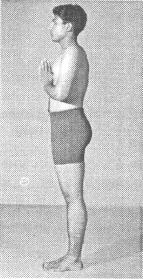 Namaskarasana (Fig 21-i) |
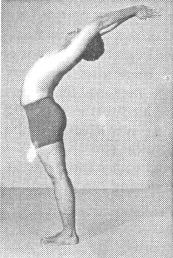 Hastottanasana (Fig 21-ii) |
2. Now breathe in deeply Raise both the hands keeping them in Namaskara pose but on both sides of the head. When both hands reach near both ears on both the sides of the head, then bend both the hands as well as head on the backward side. Do not bend hands from the elbows. Do not bend the head on the backward side before both the hands are positioned on the side of the head. This is because the centre of the body is situated in the head. If head bends towards the back earlier, the centre will go eccentric and there are chances of getting toppled over. Hence understand the instructions carefully and bend the head only when it is in the centre of both the hands. (fig 21-ii)
|
|
3. With both the hands remaining in the Namaskara position bend forward with your head. Go on releasing
the breath. Keep both the hands on both the sides of the legs. Both the palms of the hands should be fully touching the ground. Fingers and thumbs of the hands should remain pointing in the opposite direction. Knees should remain straight, should not be allowed, to bend. This type of position is not easily possible in the beginning. Do not get disheartened. Make efforts. Do not overstrain. Try to perform the pose as well as possible. Breathe out. (fig 21-iii)
4. Now breathe in. Pull the right
leg on the rear as if you were taking a stride backward. Let the right knee touch the ground. The paw of right leg should be touching the ground, heel should be in the top, left knee
|
|
should come near the chest, the head should be between two hands and pointing upward, eyes straight, chest should be up, away from the ground. (fig 21-iv)
5. Now lift the left leg and put it along side the right leg. Both the knees should be straight. Back also should be straight. The weight of the whole body will be supported on both the hands and the two paws of the legs. The whole body right from the head to the heel should remain in one line. Hold the breath — Antarkumbhaka. (fig 21-v)
|
|
6.
Knees should be kept touching the ground. Chest also should touch the ground.
Lower part of the belly as well as the buttocks be kept a little raised above
the ground. Forehead should touch the ground. Now exhale. Both the hands should
be on both sides of the chest and should be parallel to each other, the elbows
should be pointing upward. This pose is called Sashtanga Namaskara. (fig 21-vi)
 Sashtanga Namaskara asana (Fig 21-vi) |
7.
Breathe deeply. Equally share the weight of the body on both the hands
and raise forehead, head and chest upto the navel. Keep the elbows half bent. Do
not straighten both the hands. Elbows should be parallel to each other
and touching the body. Keep the fingers and the thumbs of both the hands
pointing outward; palms should be resting fully on
the ground. (fig 21-vii)
|
|
8. Now
exhale, share your weight on the palms of both the hands and on the paws of the
legs and raise the knees, back, buttocks and chest. Press the head in between
both the hands. Raise the body so that both the heels of the legs remain
touching the ground. A beautiful triangle will be described by the body Weight
of the whole body will get equally divided on both the hands and both the legs.
(fig 21-viii)
|
|
9.
Now hereafter numbers 9, 10, 11 and 12, asanas are repetition of asanas
nos. 4, 3, 2, and 1 respectively. Now remember, leg which was drawn backward in the
4th pose. Yes, that was the right leg. Allow
right leg to remain straight backward. Bring the left leg in between both the
hands. The right knee should touch the ground. Left knee should remain between
both the hands, head should be taken up, chest should
be brought forward. Now inhale.
|
|
10. To attain the 10th pose, exhale. Bring the right leg which is kept behind exactly in line with the left leg. Knees should remain straight. Both the hands should be on both the sides of the legs, keep both the palms fully touching the ground. Keep the fingers and thumbs of the hand pointing outward.
|
|
11. Slowly inhale, raise both the hands straight upward keeping both hands joined together and head lying in between the arms. Initially assume standing position with head and leg in a straight line and then bend with the hand and head behind seeing that knees and elbows do not bend.
|
Hastottanasana (Fig 21-xi) |
12. Now exhale. Bring both the hands in front of the chest. Keep both these hands in a pose of Namaskara. Breathing should be kept normal.
|
|
This
constitutes one Suryanamaskar. Initially, start by performing 2, 4, 6,
8 Namaskars. Subsequently when you perform other extra Asanas, it will be
enough if you limit to two or four Namaskars. You can at the most perform
12 Namaskars. Whether you perform two or four Namaskars, it is absolutely
essential to perform Shavasana..
MATSYASANA
By performing Matsyasana, lungs get ample supply of blood. Thereby the bronchial tubes, breathing system and air vessels gain more capacity and become active. By this exercise lungs get stretched both vertically as well as transversely and hence oxygen is breathed in full proportion and the working capacities of both the diaphragm and the lungs increase.
To
perform Matsyasana spread a blanket making it four
fold. Sit at ease. Matsyasana is mainly performed while one seats in Padmasana.
Sit in Padmasana taking right leg on the left thigh and left leg on the right
thigh. If this is not convenient, you can first keep the left leg on the right
thigh and then put right leg on the left thigh. This is also an allowable pose
of Padmasana.
1.
After sitting in Padmasana, keep both the palms of both hands on two
sides of the body. Keep the fingers and thumbs join together and pointing on the
opposite direction. Thereafter bow down slowly keeping right elbow on the ground
and left elbow also on the other side of the ground. See that knees remain
touching the ground and backside lies down on the ground.
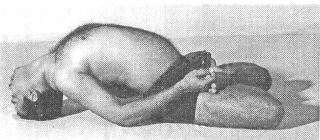 Matsyasana-1 (Fig 22-i) |
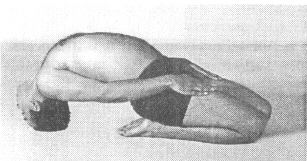 Matsyasana-2 (Fig 22-ii |
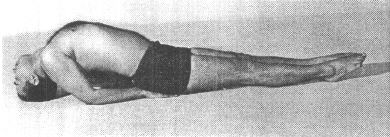 Matsyasana-3 (Fig 22-iii) |
Now keep the palms of both the hands on both sides of head so that the fingers of the hands point towards the shoulders on both the sides.
Raise
the head by taking weight on the hand, keep the head on the ground in such a
manner that the scalp of the head remains on the ground. Now hold the thumb of
both the legs by both the hands. Keep the elbows touching the ground.
Close the eyes. Breathe through the nose. (fig 22-i)
2.
We can also perform Matsyasana sitting in Vajrasana pose. When you
perform Matsyasana by sitting in Vajrasana, keep both the knees touching
each other. Keep both the hands on thighs. Keep the position of the head in the
same manner as described under No. 1 (see
fig 22-u). We may not find it convenient to
perform Matsyasana, while sitting in either Padmasan or Vajrasana. Even then in
the third pose described hereafter, you can perform Matsyasana which will give
all the advantages of Matsyasana in this third simple and easy way.
3.
Lie on your back on the ground. Keep both the legs
together. Raise the head, supporting the
weight of the body on the palms put under buttocks. Raise the shoulders also.
Now position the scalp of the head on the ground. In all the three
alternate poses of Matsyasana, the scalp of the
head will touch the ground. Keep the mouth and eyes closed. Breathe normally and
very very slowly. Thus because the lungs get stretched vertically as well
as transeversely the working capacity of the lungs increases. There will remain
no congestion in the bronchial tubes, you will get extra oxygen,
diaphragm will get exercised.
In
this manner if one performs Suryanamaskara and Matsyasana along with Ujjai,
Kapalbhati, and Bhastrika Prananyama one definitely gets quick relief in general
cold, running nose as well as cough.
Kapalbhati
is not a Pranayama but it is a process. We will now discuss further exercises
which can result in beneficial effects.
OM SHANTIH!
Latest Additions.........
|
Sivananda Yoga (Yoga DVD)
Atam Mahek (Gujarati) / Fragrance ( English) - Swami Adhyatmananda |
Yoga, A Way of Life - Sri Swami Adhyatmananda
"Yoga and Health" - a complete book with Question & Answer section by Sri Swami Adhyatmananda
|
![]()
|
Please subscribe to Divyajivan Mailing List. We will update you with new uploads of spiritual literature on the web of Holy Master Sri Swami Sivanandaji Maharaj, saints of his lineage and other saints. We will also update you about the Sivananda Ashram, Ahmedabad website and facilitate communication with Sri Swami Adhyatmanandaji Maharaj. |
|
To manage your subscription, please visit Subscription Page. You can also subscribe and unsubscribe from this page. You may unsubscribe by yourself anytime you wish. You will be required to send confirmation link that you will get in your e-mail to complete this subscription. |
![]()